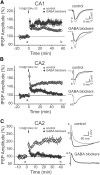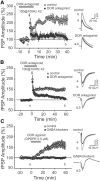Inhibitory Plasticity Permits the Recruitment of CA2 Pyramidal Neurons by CA3
- PMID: 26465002
- PMCID: PMC4596021
- DOI: 10.1523/ENEURO.0049-15.2015
Inhibitory Plasticity Permits the Recruitment of CA2 Pyramidal Neurons by CA3
Erratum in
-
Correction: Nasrallah et al., Inhibitory Plasticity Permits the Recruitment of CA2 Pyramidal Neurons by CA3 (eNeuro July/August 2015, 2(4) 10.1523/ENEURO.0049-15.2015 1-12 http://dx.doi.org/10.1523/ENEURO.0049-15.2015).eNeuro. 2016 Jan 11;2(6):ENEURO.0137-15.2015. doi: 10.1523/ENEURO.0137-15.2015. eCollection 2015 Nov-Dec. eNeuro. 2016. PMID: 26984103 Free PMC article.
Abstract
Area CA2 is emerging as an important region for hippocampal memory formation. However, how CA2 pyramidal neurons (PNs) are engaged by intrahippocampal inputs remains unclear. Excitatory transmission between CA3 and CA2 is strongly inhibited and is not plastic. We show in mice that different patterns of activity can in fact increase the excitatory drive between CA3 and CA2. We provide evidence that this effect is mediated by a long-term depression at inhibitory synapses (iLTD), as it is evoked by the same protocols and shares the same pharmacology. In addition, we show that the net excitatory drive of distal inputs is also increased after iLTD induction. The disinhibitory increase in excitatory drive is sufficient to allow CA3 inputs to evoke action potential firing in CA2 PNs. Thus, these data reveal that the output of CA2 PNs can be gated by the unique activity-dependent plasticity of inhibitory neurons in area CA2.
Keywords: area CA2; disinhibition; hippocampus; interneuron; long-term depression; δ opioid receptor.
Conflict of interest statement
The authors declare no competing financial interests.
Figures






Similar articles
-
Bi-directional interplay between proximal and distal inputs to CA2 pyramidal neurons.Neurobiol Learn Mem. 2017 Feb;138:173-181. doi: 10.1016/j.nlm.2016.06.024. Epub 2016 Jun 25. Neurobiol Learn Mem. 2017. PMID: 27353717
-
Routing Hippocampal Information Flow through Parvalbumin Interneuron Plasticity in Area CA2.Cell Rep. 2019 Apr 2;27(1):86-98.e3. doi: 10.1016/j.celrep.2019.03.014. Cell Rep. 2019. PMID: 30943417
-
Sequential inhibitory plasticities in hippocampal area CA2 and social memory formation.Neuron. 2022 Sep 7;110(17):2854-2866.e4. doi: 10.1016/j.neuron.2022.06.013. Epub 2022 Jul 19. Neuron. 2022. PMID: 35858622
-
Hippocampus as comparator: role of the two input and two output systems of the hippocampus in selection and registration of information.Hippocampus. 2001;11(5):578-98. doi: 10.1002/hipo.1073. Hippocampus. 2001. PMID: 11732710 Review.
-
gamma-Aminobutyric acid (GABA): a fast excitatory transmitter which may regulate the development of hippocampal neurones in early postnatal life.Prog Brain Res. 1994;102:261-73. doi: 10.1016/S0079-6123(08)60545-2. Prog Brain Res. 1994. PMID: 7800817 Review.
Cited by
-
Altered inhibitory function in hippocampal CA2 contributes in social memory deficits in Alzheimer's mouse model.iScience. 2022 Feb 9;25(3):103895. doi: 10.1016/j.isci.2022.103895. eCollection 2022 Mar 18. iScience. 2022. PMID: 35243253 Free PMC article.
-
Input-Timing-Dependent Plasticity in the Hippocampal CA2 Region and Its Potential Role in Social Memory.Neuron. 2017 Aug 30;95(5):1089-1102.e5. doi: 10.1016/j.neuron.2017.07.036. Epub 2017 Aug 17. Neuron. 2017. PMID: 28823730 Free PMC article.
-
Age-Dependent Specific Changes in Area CA2 of the Hippocampus and Social Memory Deficit in a Mouse Model of the 22q11.2 Deletion Syndrome.Neuron. 2016 Jan 6;89(1):163-76. doi: 10.1016/j.neuron.2015.11.036. Neuron. 2016. PMID: 26748091 Free PMC article.
-
Group III metabotropic glutamate receptors gate long-term potentiation and synaptic tagging/capture in rat hippocampal area CA2.Elife. 2020 Apr 20;9:e55344. doi: 10.7554/eLife.55344. Elife. 2020. PMID: 32310084 Free PMC article.
-
Perineuronal Nets Suppress Plasticity of Excitatory Synapses on CA2 Pyramidal Neurons.J Neurosci. 2016 Jun 8;36(23):6312-20. doi: 10.1523/JNEUROSCI.0245-16.2016. J Neurosci. 2016. PMID: 27277807 Free PMC article.
References
-
- Benes FM (1999) Evidence for altered trisynaptic circuitry in schizophrenic hippocampus. Biol Psychiatry 46:589–599. - PubMed
-
- Benes FM, Kwok EW, Vincent SL, Todtenkopf MS (1998) A reduction of nonpyramidal cells in sector CA2 of schizophrenics and manic depressives. Biol Psychiatry 44:88–97. - PubMed
LinkOut - more resources
Full Text Sources
Miscellaneous
